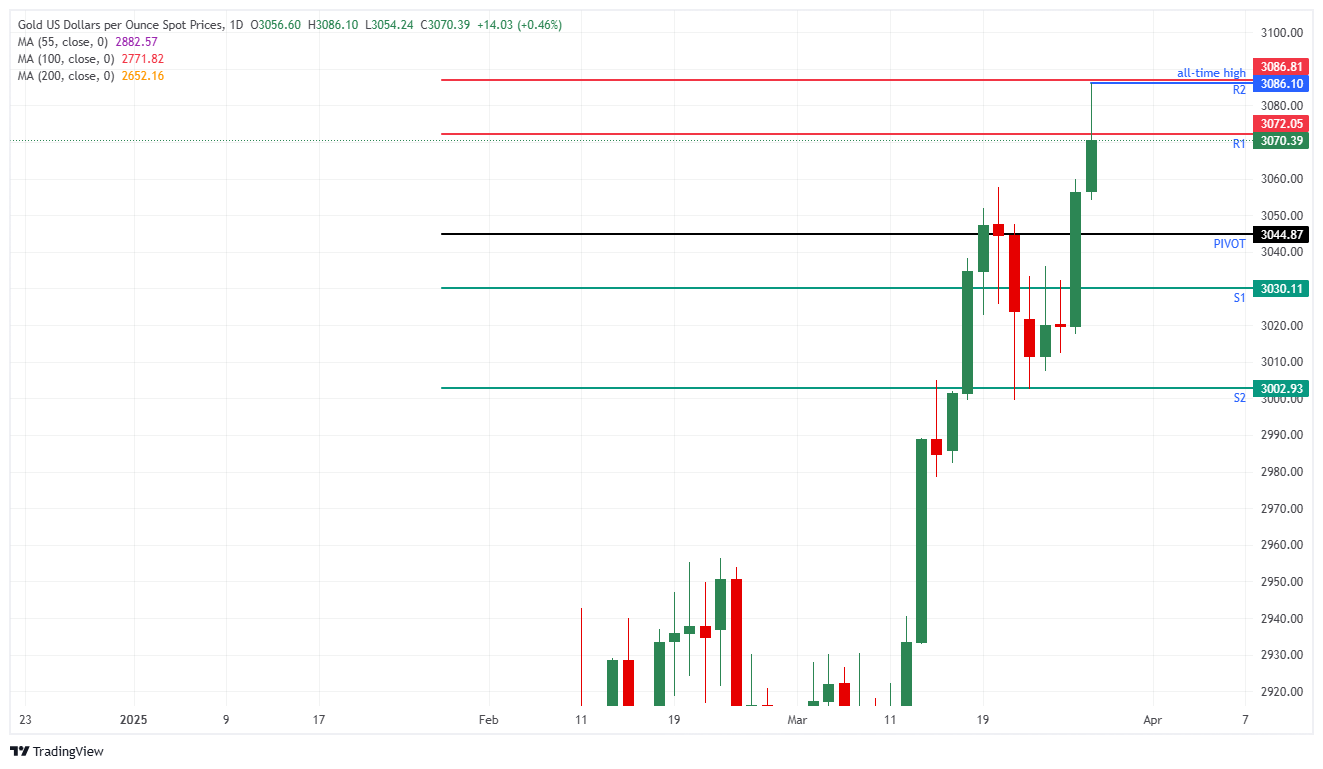Gold stretches its rally to $3,086 and hits a fresh all-time high
- Gold price surges over 0.5% and ekes out a fresh all-time high at $3,086.
- Markets flee into safe-haven Gold as losses in Equities and Cryptocurrencies mount.
- Gold traders are now targeting $3,100 in the near term.
Gold price (XAU/USD) is penciling another record performance this Friday, hitting $3,086 as the new all-time high for now and trading around $3,075 at the time of writing. Bullion sees another wave of safe-haven inflow, this time from investors that are exiting Equity and Crypto positions. From here, the next big psychological target and level to beat will be $3,100.
Later this Friday, the US Personal Consumption Expenditures (PCE) data for February is due. The overall consensus is for rather steady numbers, with the monthly core PCE expected to remain unchanged at 0.3%, while the headline figure should remain cemented at 0.3% as well.
These past few days, inflation concerns in the United States (US) have been picking up as the impact of the United States (US) President Donald Trump’s tariff implementations on inflation is hard to measure. The risks of the US economy heading into recession or stagflation are major concerns for investors and could bring moves in Equity and Bond markets, and see Gold extending further.
Daily digest market movers: Lost track of it all, good for Gold
- Inflation in France and Spain undershot expectations this Friday, supporting calls for more interest rate cuts by the European Central Bank (ECB). The French headline Consumer Price Index year-on-year grew steadily by 0.9% this month, defying analyst predictions for an uptick. In Spain, it slowed by 2.2%, a much deeper deceleration than expected, and is the first country that approaches the ECB’s target of 2%, Bloomberg reports.
- Some fair-value modeling reveals that Gold is 13% overvalued, suggesting that further policy uncertainty regarding US tariff execution is already factored in. A peace deal for Ukraine could see the precious metal give up some gains as geopolitical risk perceptions ease, Reuters reports.
- On Thursday, US President Donald Trump signed a proclamation to implement a 25% tariff on auto imports and pledged harsher punishment on the EU and Canada if they join forces “to do economic harm” against the US, while April 2nd approaches fast for the so-called reciprocal tariff implementation, Bloomberg reports.
Gold Price Technical Analysis: Analyst calls remain bullish
Traders are starting to throw in the towel on Equities and Crypto, with Gold being the hottest place in town. More and more analysts are revising their calls for Gold to higher levels, which means that a crucial point of being ‘overbought’ is starting to grow. Taking part in the rally still makes sense, but at least paying attention to specific levels will make the trade more manageable on where to get in, where to take profit, or when to stop it out.
On the upside, the daily R1 resistance for XAU/USD comes in at $3,072 and has already been tested earlier this Friday. Further up, the R2 resistance at $3,086 coincides with the fresh all-time high. Once from there the $3,100 mark looks far off, but still, it could see the rally at least move in that direction.
On the downside, the first support to be considered is the daily Pivot Point at $3,044, followed by the intraday S1 support at $3,030. Further down, the S2 support comes in at $3,002, which roughly coincides with the $3,000 mark psychological level.

XAU/USD: Daily Chart
Gold FAQs
Gold has played a key role in human’s history as it has been widely used as a store of value and medium of exchange. Currently, apart from its shine and usage for jewelry, the precious metal is widely seen as a safe-haven asset, meaning that it is considered a good investment during turbulent times. Gold is also widely seen as a hedge against inflation and against depreciating currencies as it doesn’t rely on any specific issuer or government.
Central banks are the biggest Gold holders. In their aim to support their currencies in turbulent times, central banks tend to diversify their reserves and buy Gold to improve the perceived strength of the economy and the currency. High Gold reserves can be a source of trust for a country’s solvency. Central banks added 1,136 tonnes of Gold worth around $70 billion to their reserves in 2022, according to data from the World Gold Council. This is the highest yearly purchase since records began. Central banks from emerging economies such as China, India and Turkey are quickly increasing their Gold reserves.
Gold has an inverse correlation with the US Dollar and US Treasuries, which are both major reserve and safe-haven assets. When the Dollar depreciates, Gold tends to rise, enabling investors and central banks to diversify their assets in turbulent times. Gold is also inversely correlated with risk assets. A rally in the stock market tends to weaken Gold price, while sell-offs in riskier markets tend to favor the precious metal.
The price can move due to a wide range of factors. Geopolitical instability or fears of a deep recession can quickly make Gold price escalate due to its safe-haven status. As a yield-less asset, Gold tends to rise with lower interest rates, while higher cost of money usually weighs down on the yellow metal. Still, most moves depend on how the US Dollar (USD) behaves as the asset is priced in dollars (XAU/USD). A strong Dollar tends to keep the price of Gold controlled, whereas a weaker Dollar is likely to push Gold prices up.

